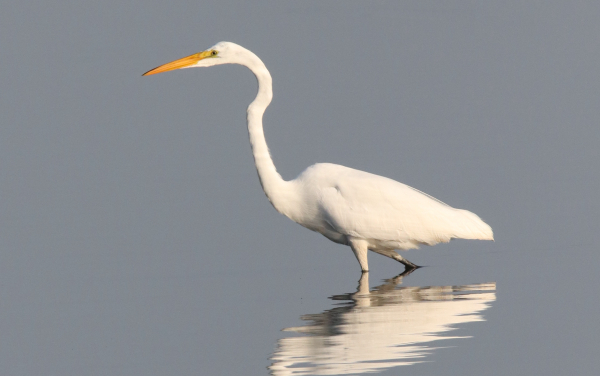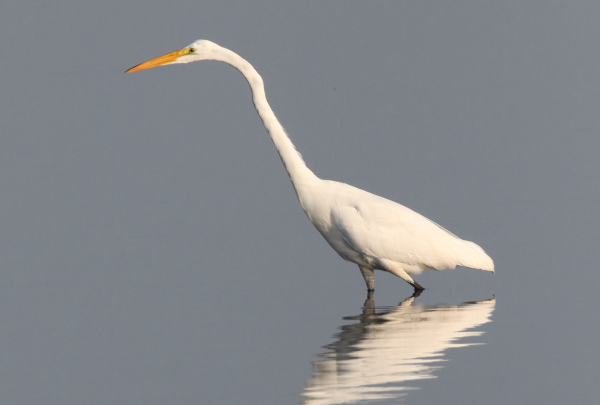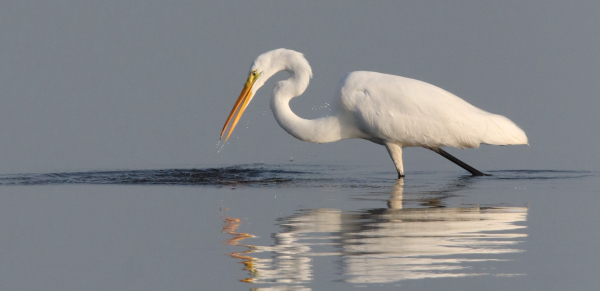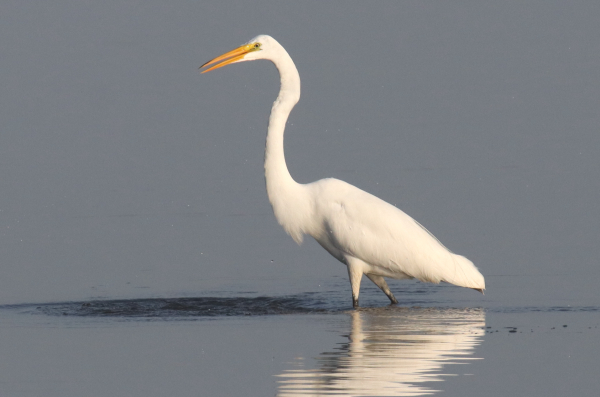Some nice sunny days with less and less wind on area waters inspired me to make some extra time for photography last week, but although there were some exceptional birds on hand, I didn’t have much luck getting a standout image or a series of photos. But sometimes it seems we try a little too hard, searching for the out of the ordinary bird or situation that will set our photos apart. Realizing that, before I headed out Sunday afternoon decided I wanted to balance my interests with those of birders who are beginning to take photographs of birds, beginners who find relatively common birds to be new or even exceptional photo subjects.

A simple, pleasing image of a large bird in a uniformly colored setting can provide a calming sensation from a viewer’s perspective. The technical settings for each of the photos below are the same as the settings for this image (600mm zoom lens, f-8 aperture, 1/2000 shutter speed, 800 ISO).
Then too, sometimes what is common in my area, might be an exciting find in another state or region. That’s when I expanded my interests in the birds around me by photographing a fairly common, widely scattered species that caught my attention just 1½ miles from home – a tall white Great Egret, even though it was inanimate, simply resting. Thereafter, I encountered a wide variety of other birds to focus my camera lens on, starting with a Belted Kingfisher, Red-tailed Hawks, Swainson’s Hawks, Solitary Sandpipers, Western Grebes, Double-crested Cormorants, White Pelicans, Great Blue Herons, and in fading light, a Merlin.
Between my encounters with the Solitary Sandpipers and Merlin, another Great Egret – one of many – caught my attention as it was slowly wading in glassy shallow water on the edge of Sand Lake. As the primo light of this sunny day was about to begin fading, I imagined the potential of a pleasing photograph, or even a series of photos if I spent some extra time in the bird’s presence. It was a Great Egret with angel white plumage and a yellow beak and eyes, standing tall as it ever so slowly inched forward, sometimes only stretching its long neck forward as if to look for underwater prey.

While the first photograph could stand alone, when the Great Egret began stretching its neck upward and forward, it became clear it was time to anticipate the bird’s next move, and document the action in a series of photos. Avoid centering a bird in your photo frame; instead show more space in front of the bird, especially if the bird may take action.
The view through my camera lens at full magnification revealed a perfectly simple scene with a simple subject surrounded by uniformly colored blue-gray water. Simplicity, lighting, color, calm water, a trusting subject that filled most of the photo frame – just what any birder would appreciate toward the end of the day, me included. From a composition standpoint, it’s best to avoid centering the subject in your photo frame. Instead, show more space in front of the bird, especially if the bird may take action – it will probably walk, run, wade, swim, or fly in the direction it is facing.
The egret’s neck became my point of interest as I watched it through my zoom lens; the white egret extended, turned, raised and lowered its neck as it searched the water ahead. The big white egret stretched its neck far forward above the water, retracted it a bit, then lowered its beak as if ready to strike; then the water exploded as the egret’s beak and head splashed water to the sides. I watched for a fish as the egret raised its neck, revealing an empty yellow beak – no luck for the big wading bird that time.

The Strike! Would the egret rise from the water with a fish? Not this time, but it’s always exciting to record the fast action of a hunting strike from a wading bird, or another bird you encounter.
In moments, the process was repeated as the egret silently eased forward a couple careful steps without revealing a ripple on the surface of the water. It made another unsuccessful strike into the water before edging into a small stand of cattails, completing my Great Egret photo session. In the end, the series of photos was worthy of the time, effort, and joy while photographing. It was also rewarding to view the resulting photos Sunday evening, to select the best representatives of the action, and crop them in appropriate ways to fit into the wide format of this Bird Photography feature.
On the tech side, I used the same settings for each of the photos; a basic f-8 aperture that provided a fast 1/2000 shutter speed in the bright late afternoon sunlight with my usual 800 ISO setting. I was using my Tamron 150-to-600mm zoom lens at the maximum 600mm magnification – simple enough. It’s also important to point out that I’ve become more conscious of the changing time frame of the peak sunlight period. Here in the Northern Plains, the prime time for afternoon photography is about 5pm to 7pm. The sunlight was a little harsher during the hour before that, but produced good photo results nonetheless, partly as a result of the sun being positioned a bit farther south than during summer afternoons.

The tall egret provided another look as it regained its composure, an image that provided a bookend to the series of photos as it hunted the shallows in beautiful afternoon sunlight at Sand Lake National Wildlife Refuge in South Dakota.
The moral of this story may be that it’s worth thinking twice before moving past a “common” bird. Give it a second look and see what you can make of it. And if you are fairly new to bird photography, take advantage of the chance to practice on birds you encounter often. Larger birds are easier to work with in the beginning, but give smaller birds their due as photo subjects too. On a personal note, I also wanted to point out that for the second week in a row, I’ve featured photographs I took in a bordering state, this time South Dakota, last week Minnesota. Where will your next birding adventure take you?
Article and Photographs by Paul Konrad
Share your bird photos and birding experiences at editorstbw2@gmail.com